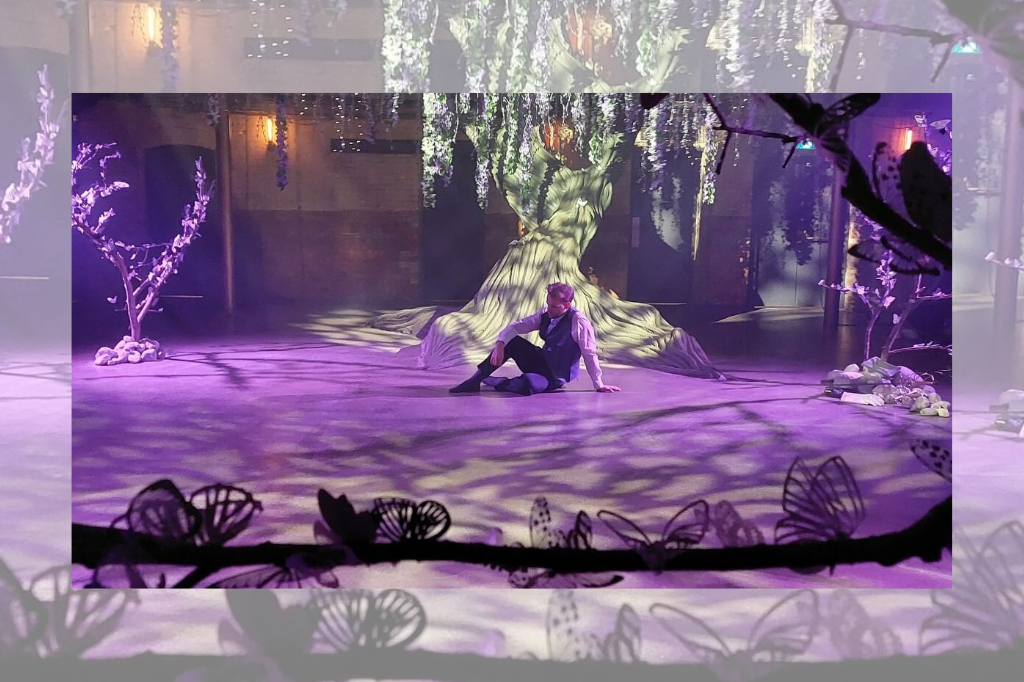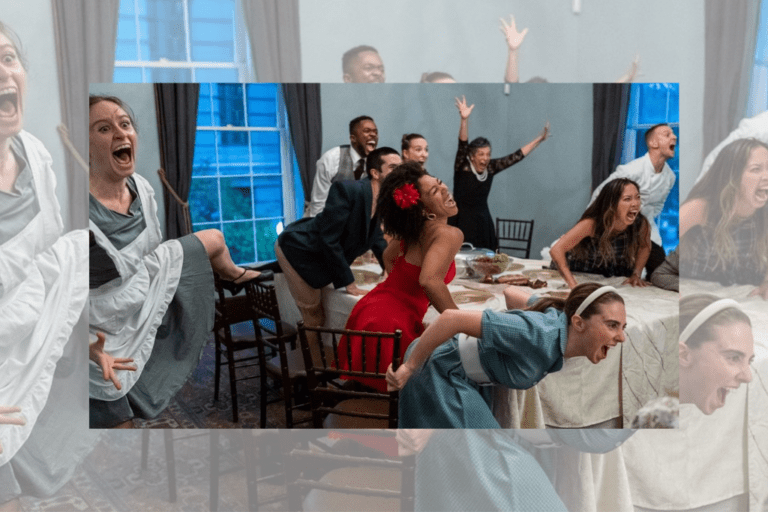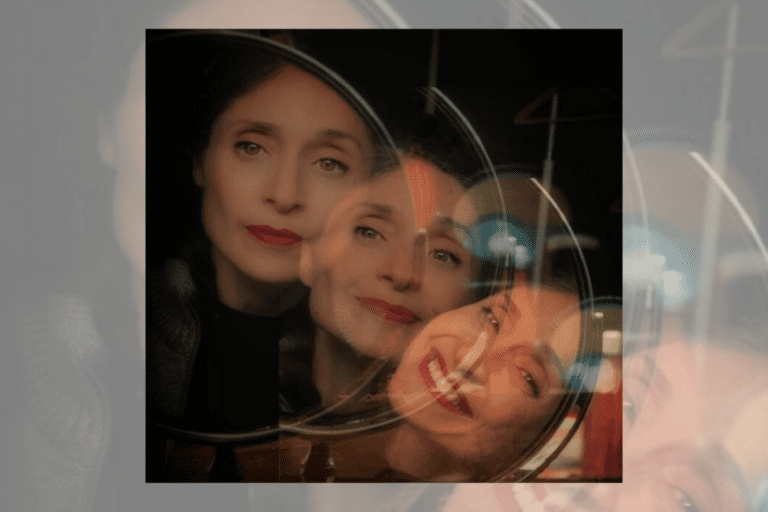REVIEW: A Grimm Night at TranscenDance
The day is cold and gray, Queen Street glistens in the rain, and a crowd gathers at the doors of the Great Hall. Soon, we will enter a fantasy world. Guests murmur in anticipation. A handful of them saw this production before in 2022 and are thrilled to be back; some are here for the first time; others still have no idea what to expect.
This sets the tone for TranscenDance’s immersive experience, A Grimm Night, directed and choreographed by Julia Cratchley. We’re given invitations with wax seals and masquerade masks and led to the main hall where there’s live violin playing as Prince Charming (Tyler Gledhill), the Master of Ceremonies (Clayton Gray), and the Evil Queen (Sam Darius) move around in character. Once the clock strikes 7:30 the story begins with a charming framing device — the Master of Ceremonies invites us to step into the world of fantasy where “explore, you must” and “this whole building is our storybook.”
The audience opens their invitations, which direct them to one of three locations to begin the experience. Once you follow that initial prompt, what you see is up to you — whether you stay in one place or let your curiosity guide you through this whimsical world.
The production tells the stories of Cinderella and Sleeping Beauty, two of Grimm’s fairy tales, through dance, using the entirety of the breathtaking venue. The three main locations are the Enchanted Forest in the basement, the Main Hall, and the Boudoir. The stories and characters are not confined to specific areas: each performer has a track through the venue that they follow. It seems the stories repeat twice each performance, allowing audience members to follow different characters during the second half of the performance.
I began my night in the Enchanted Forest, where the Evil Queen puts a curse on Rose (Sarah MacDonald) and Cinderella (Kelly Shaw) passes through with her glass slippers. The Main Hall is where Rose’s story begins and Cinderella’s ends. The tales are orchestrated to overlap, and to immerse the audience in both.
Observing any individual character reveals how thoroughly detailed this world is: each performer moves through the space with intention, even when they are not the focal point. The Creature (Brianna Clarke) is a deer with beguiling makeup and golden antlers who interacts playfully with the audience, in between making appearances in the Enchanted Forest. These interactive moments feel like little stories of their own. There’s something special about being one of a small number of people witnessing a given moment — each person will leave A Grimm Night having experienced their own version of the fairy tales.
It is in the stairwells and hallways that this world comes alive in a truly exceptional way. Everyone involved appears to have a tremendous sense of detail and commitment to the immersion. My trajectory drew my attention to Rose and her team of faeries (Tyler Angell, Dana MacDonald, and Evan Webb), all four of whom stand out not only for their skill as dancers, but also for their audience interaction, animating the liminal spaces between venues as they travel from location to location. Similarly, the stepsisters (Martha Hart and Jazzmin James) are phenomenal, giggling joyfully and glaring wickedly.
The music composed by Owen Belton ties every location together and keeps time throughout. Belton’s score is atmospheric and punctuated by moments in which the intensity ramps up in time with the rising action in the narratives. Dreamy instrumentals allow the audience to explore at their own pace; the music is not the focal point, but perfectly supports the staging.
Cratchley’s choreography is excellent, and the performers execute it with total focus, adapting their movement to accommodate and interact with the audience. The improvisational quality of the production makes their performances all the more impressive. They never falter, never break character. The dancing conveys emotion and narrative clearly and with impact. Many dancers (especially MacDonald) use breath to intensify their performances, which is quite potent for any audience members standing nearby. Colleen Snell’s fight choreography further enhances the dancing, amping up the tension and suspense.
Orchestrating the logistics of a performance of this scale takes skill and organization. The stage manager (Patrick Lynn) and front of house manager (Zoe Kenneally) make difficult feats look easy. The ushers are also indispensable for ensuring that the experience goes smoothly.
Yulia Kinshakova’s costume design is lovely and conveys characterization while allowing performers a full range of movement. Jennifer Goodman and Cratchley’s lighting design is a cohesive part of the world — it seems only natural that there would be dappled sunlight and a soft purple glow in the basement-turned-enchanted garden. It’s a crucial part of the transformation the space has undergone to become the beautiful, detailed world of A Grimm Night — which is anything but grim.
Investigating Annie Lujan and Audrienna Martin Del Campo’s detailed set dressing is a worthwhile pursuit. The dressing of the enchanted garden is appropriately magical, including trees decorated with shiny paper butterflies which on closer inspection house handwritten messages (Noelle Hamlyn designed this element). Details like these ensure there is never a moment without plenty to look at.
The dancers make their work look effortless, but by the end of the performance, knowing they perform the show twice in one evening, I wonder how sustainable it is. The athletic feats of choreography with little or no time away from the eyes of the audience must be a marathon. I worry too about performers in bare feet traversing spaces that audiences in outdoor shoes have also passed through — that safety concern lingered at the back of my mind as I watched.
The production is clearly costly, which is part of why it is so thoroughly immersive, from providing the audience with masquerade masks, to the design, to the cast of 13 performers who bring every part of the venue to life. There are high ticket prices to match, which may make it inaccessible to some audiences. That said, A Grimm Night is unique and intimate, and was a night I will not soon forget. Its immersive nature is not a marketing gimmick — it’s essential to the performance. The familiar narratives allow the skill of the dancers and brilliance of design elements to shine. Exploring this lush world of artistic expression is truly, yes, enchanting.
A Grimm Night runs at the Great Hall though April 9. Tickets are available here.











Comments